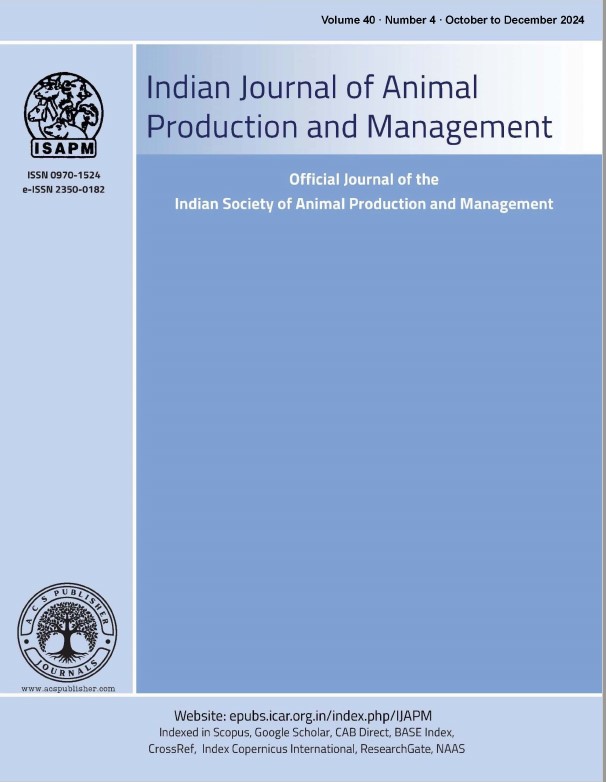GROWTH, CARCASS TRAITS AND GAS PRODUCTION IN NELLORE SHEEP FED COMPLETE DIETS SUPPLEMENTED WITH THERMOTOLERANT PROBIOTIC YEAST*
Keywords:
Carcass traits, Feed conversion, Growth, In vitro gas production, Nellore ram lambs, Thermotolerant yeastAbstract
A complete diet was formulated and supplemented with three levels of thermotolerant yeast-Saccharomyces cerevisiae (0 g/kg-control (CON); 1 g/kg (TPY1); 2 g/kg (TPY2) and 3 g/ kg (TPY3) to determine the appropriate level for inclusion in sheep diet by in vitro gas production (IVGP) technique. Eighteen Nellore ram lambs (12.33 ± 0.08 kg initial body weight, aged 3 months) were assigned randomly in the 180 days experiment to one of three groups to see the effect on intake, growth, feed conversion and carcass traits. Treatment diets were no yeast (CON; n = 6), with 1 g/kg mesophilic yeast strain-MTCC-1813 (MPY1; n = 6) and with 1 g/kg thermotolerant yeast strain-OBV-9 (TPY1; n = 6). There was significantly (P<0.01) higher IVGP, in vitro organic matter degradability, metabolizable energy and total degradable organic matter on rations TPY1, TPY2 and TPY3 compared to CON diet. Partitioning factor and efficiency of microbial biomass production were higher (P<0.05) on rations TPY1 and TPY2 and higher (P<0.01) microbial biomass production on rations TPY1, TPY2 and TPY3 compared to CON were recorded. Dry matter intake (DMI), DMI (% b. wt.) and DMI/kgW0.75 were higher (P<0.01) in TPY1 group than CON and MPY1 groups, while intake of organic matter and crude protein was similar in all the groups. Intake of neutral detergent fibre and acid detergent fibre was higher (P<0.01) in lambs fed TPY1 diet than CON and MPY1 diets. The final body weight, total gain and average daily gain were higher (P<0.01) on TPY1 followed by MPY1 compared to CON group. Lambs receiving TPY1 and MPY1 diets had better (P<0.05) feed conversion ratio and cost of gain than CON diet. The test diets did not affect dressing percentage, though there was a higher (P<0.01) carcass weight compared to CON diet. No differences were also observed between test diets (TPY1 and MPY1) for per cent proportions of carcass cuts, except proportions of leg (higher (P<0.05) in TPY1 group) and test diets (TPY1 and MPY1) not affected proportions of lean, bone and fat and bone to meat ratios but significantly higher (P<0.01) per cent weights of edible components and lower (P<0.01) per cent weights of non edible components were recorded in both test diets. The study concludes that, diets supplemented with 1 g/kg thermotolerant yeast improved the performance and certain carcass characteristics of Nellore ram lambs in comparison with mesophilic yeast, while being cost effective.

